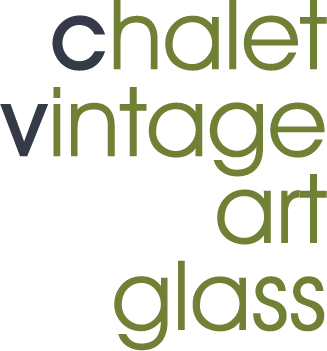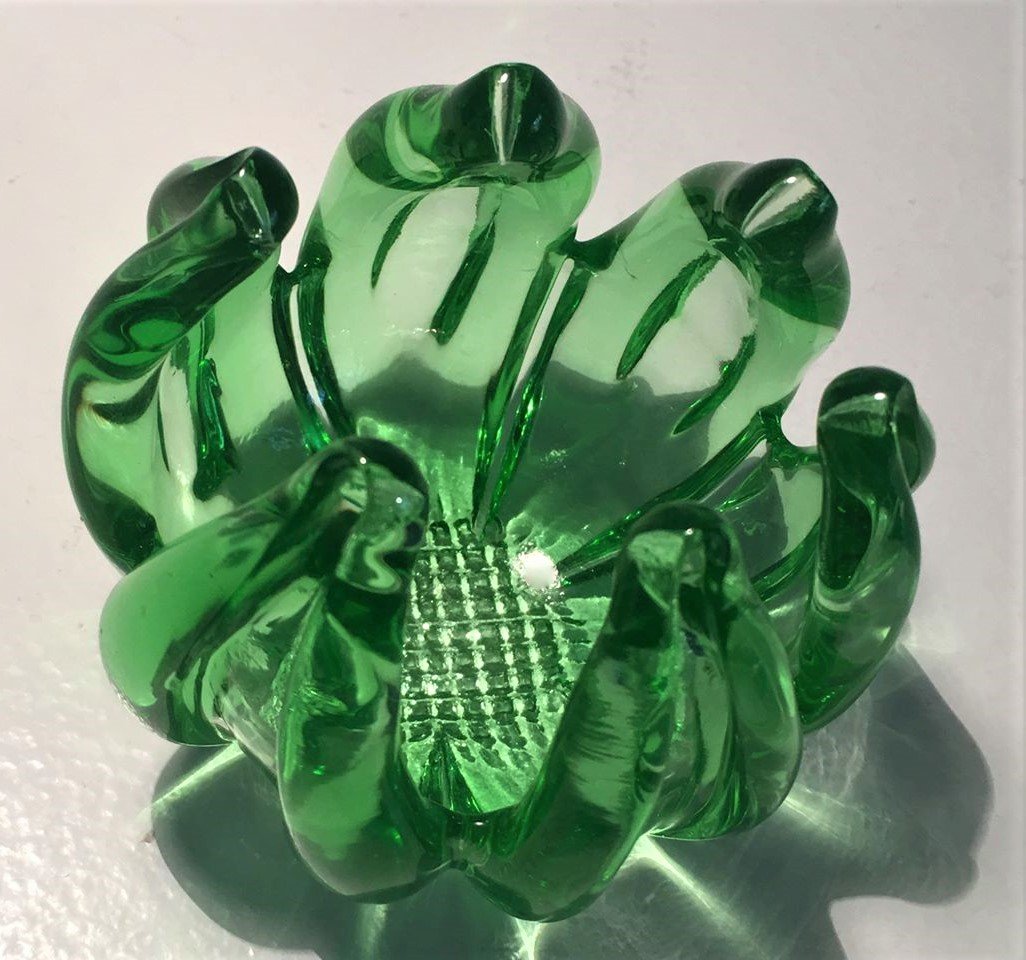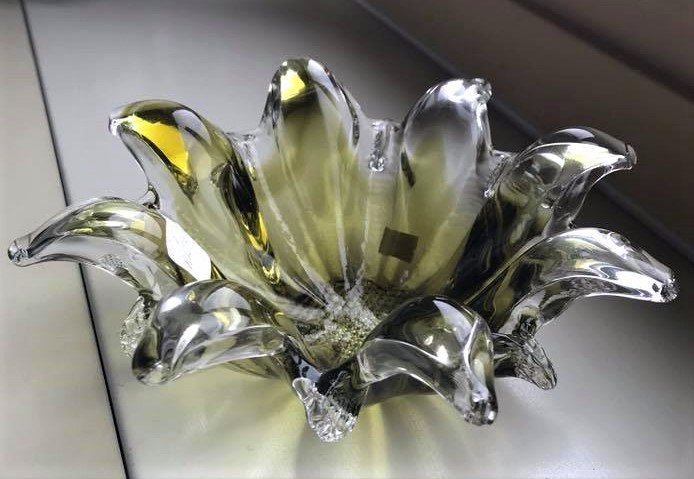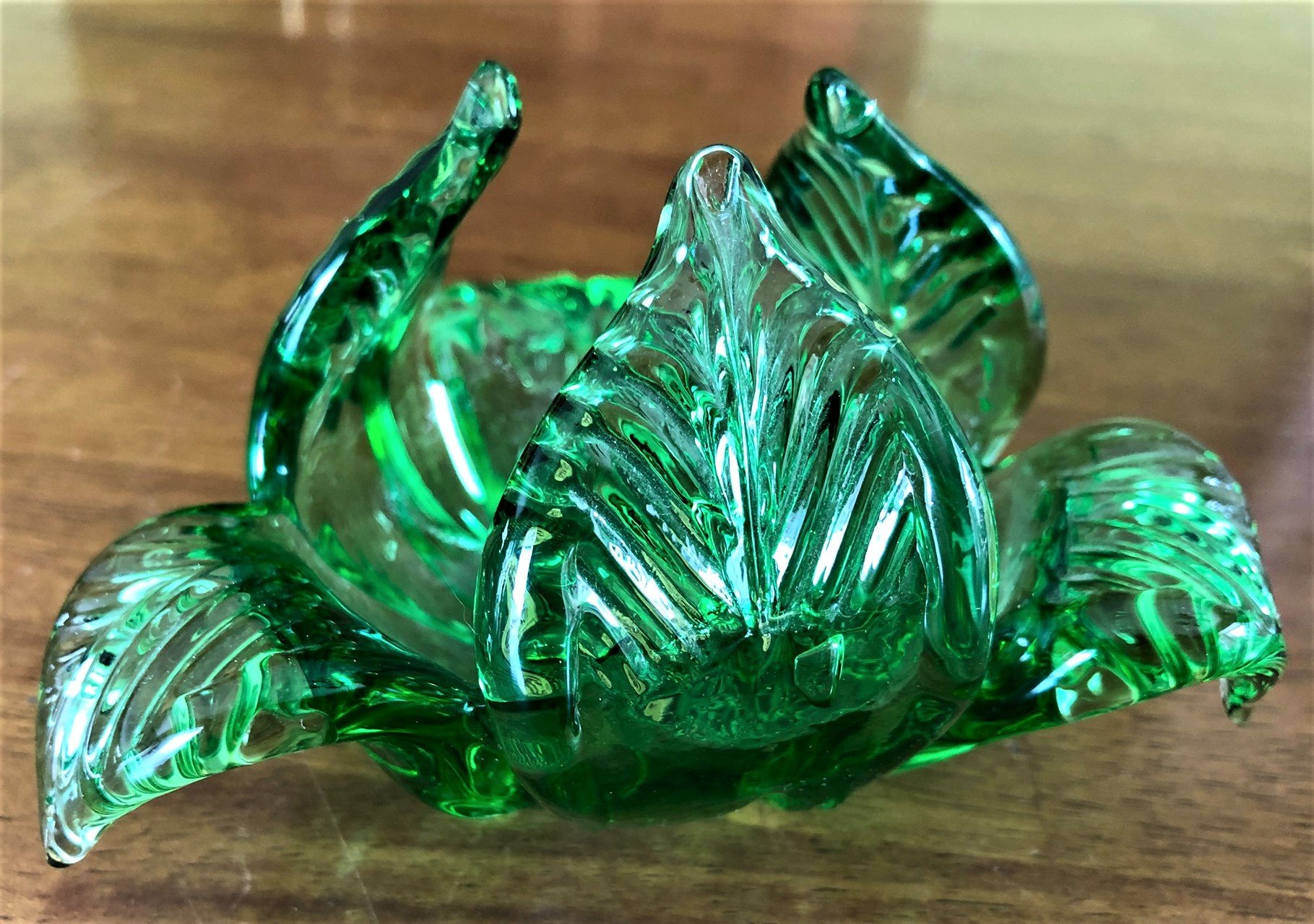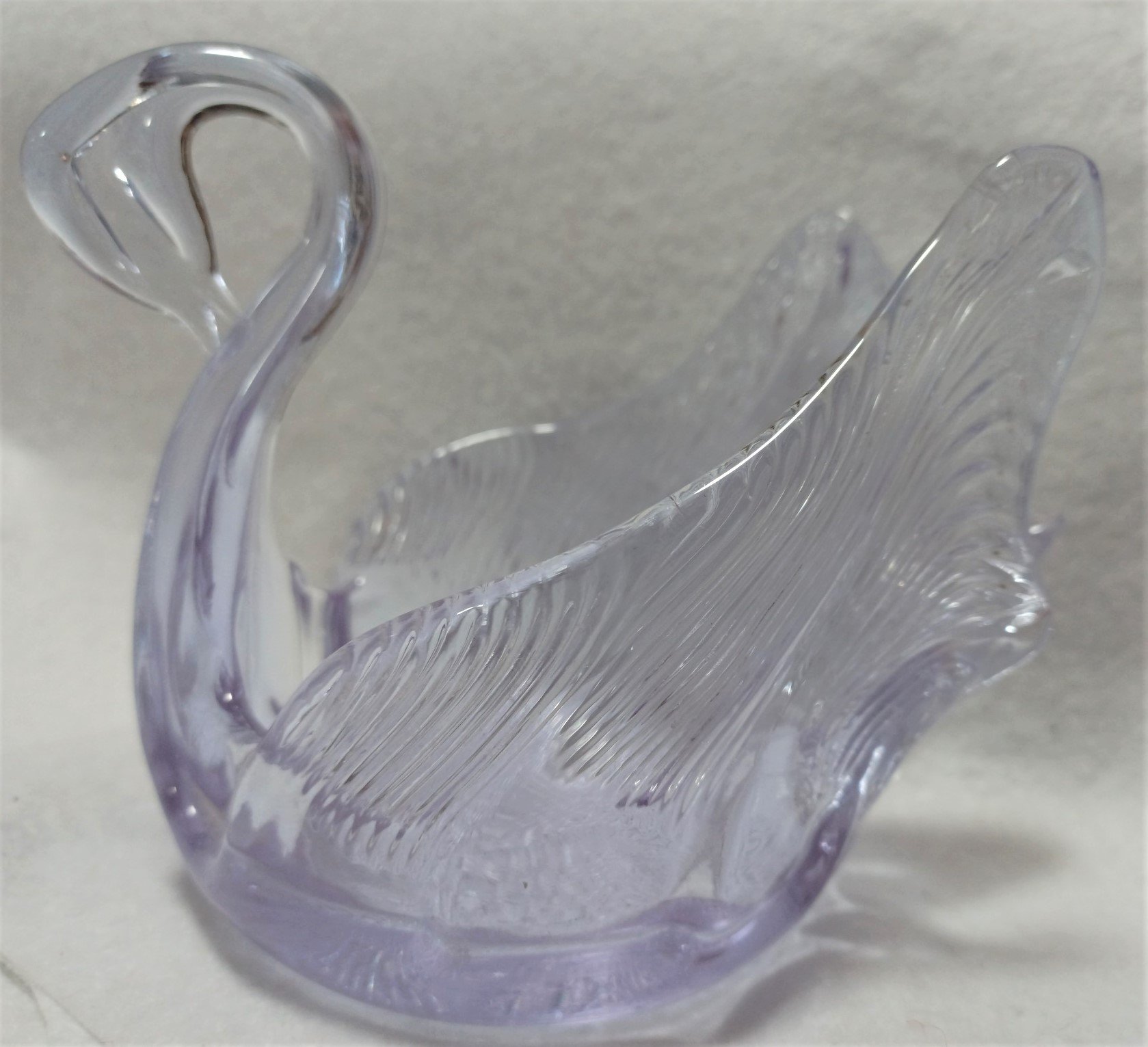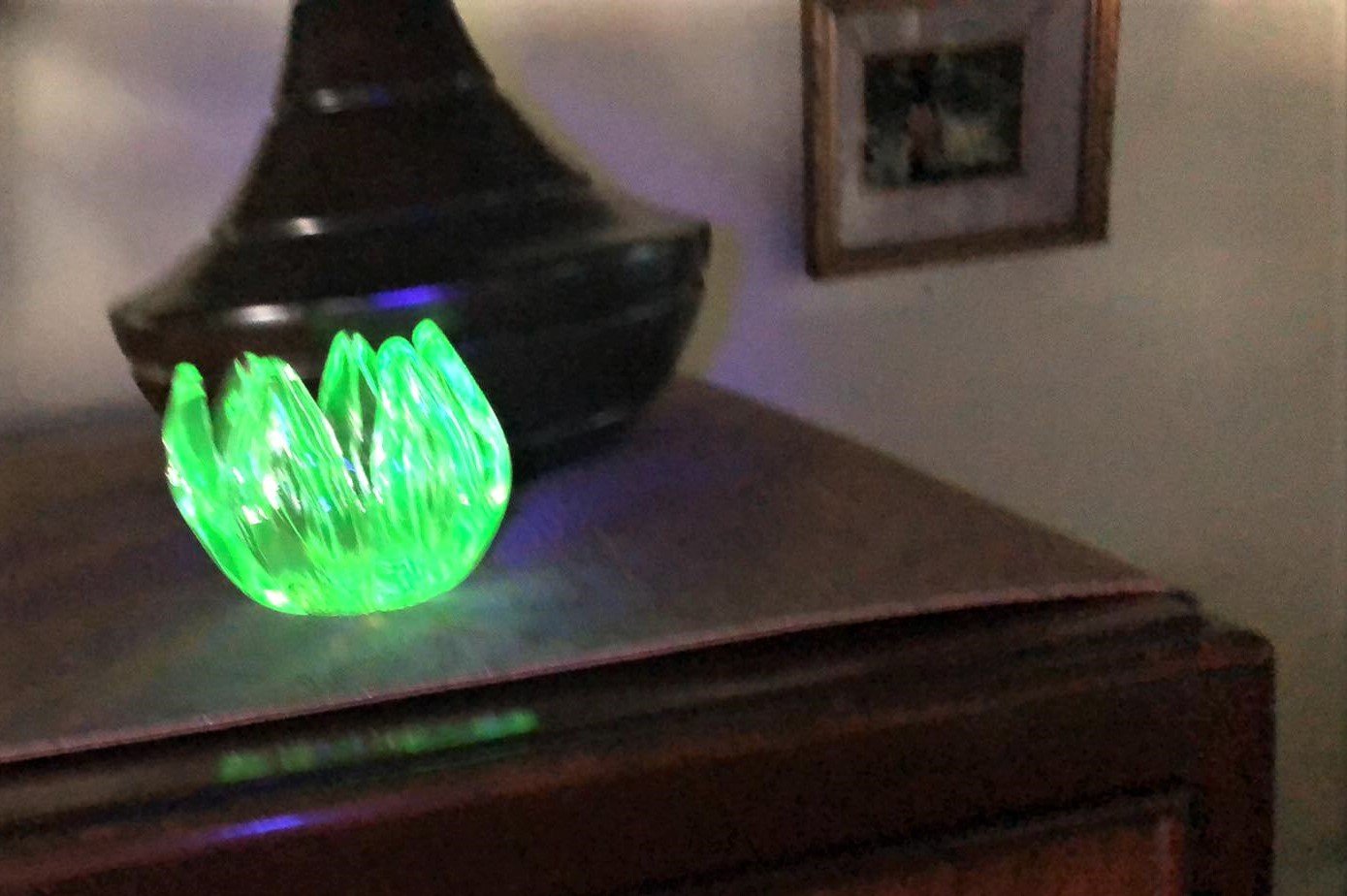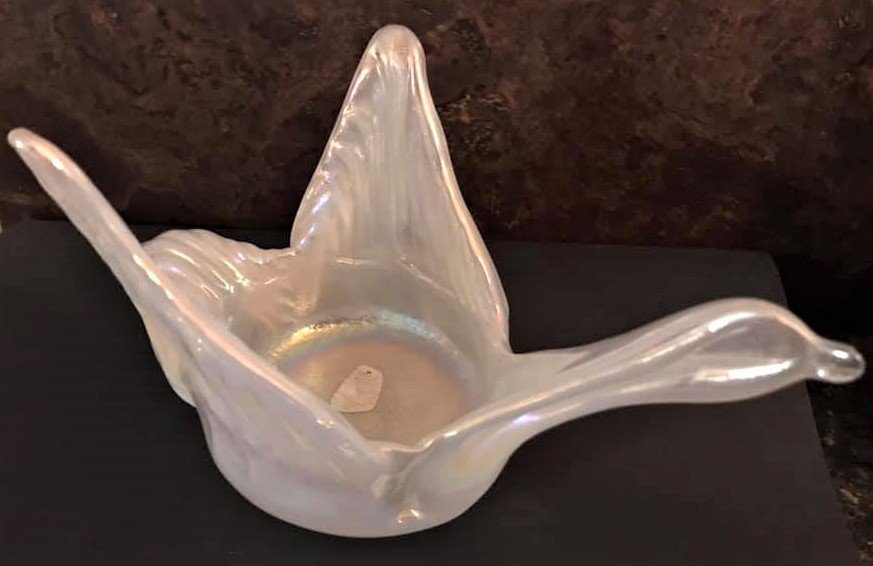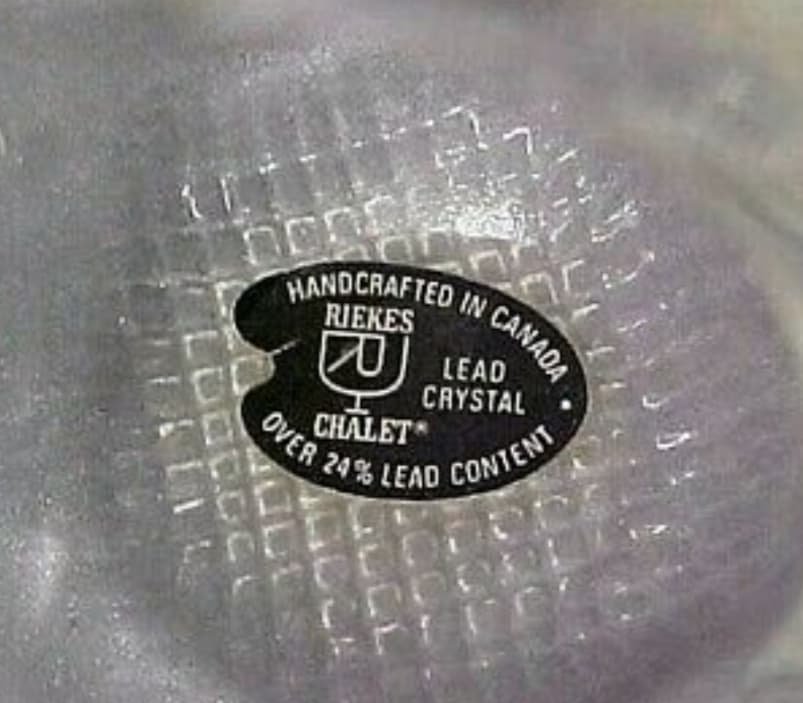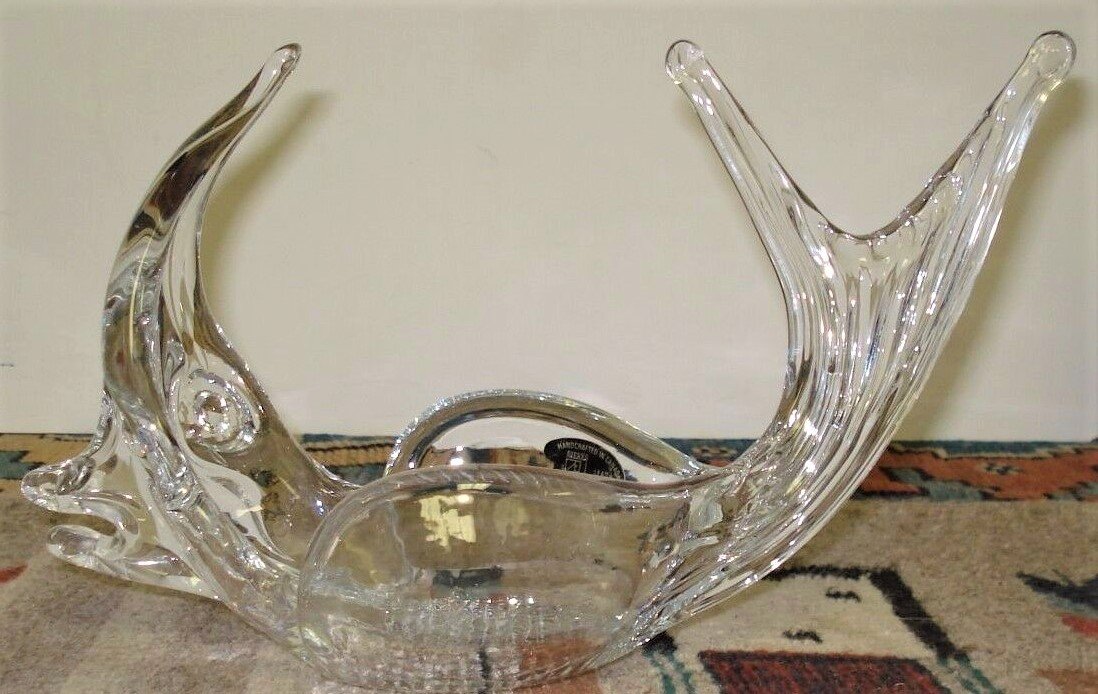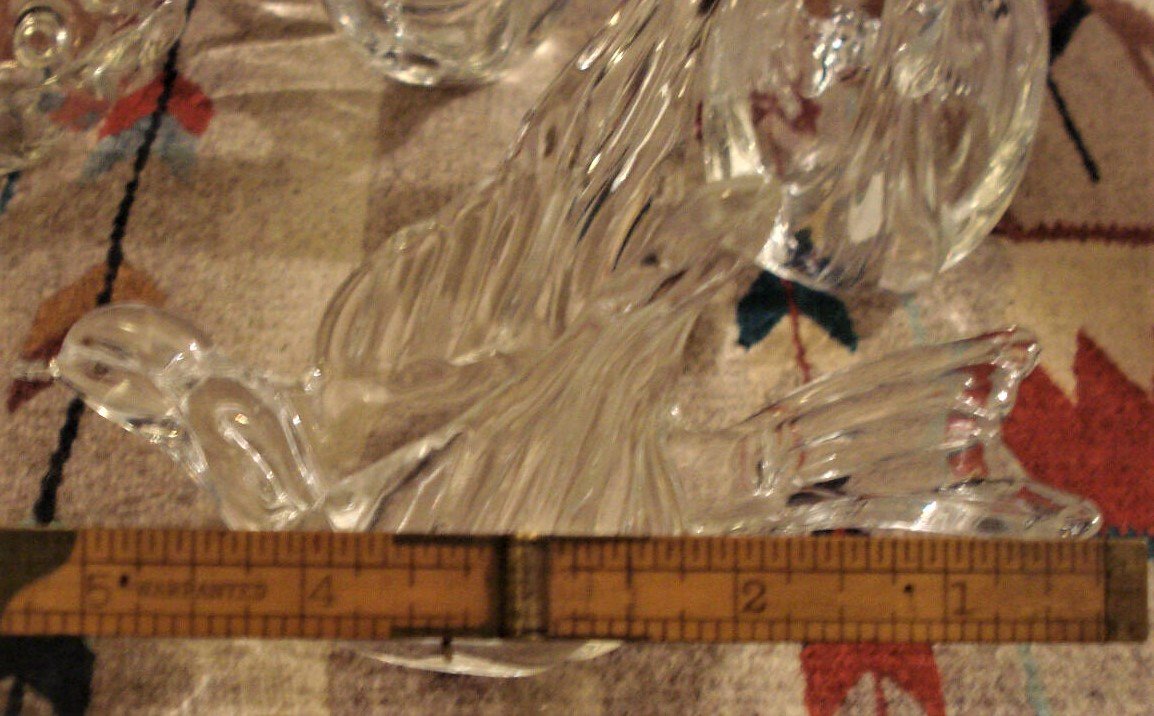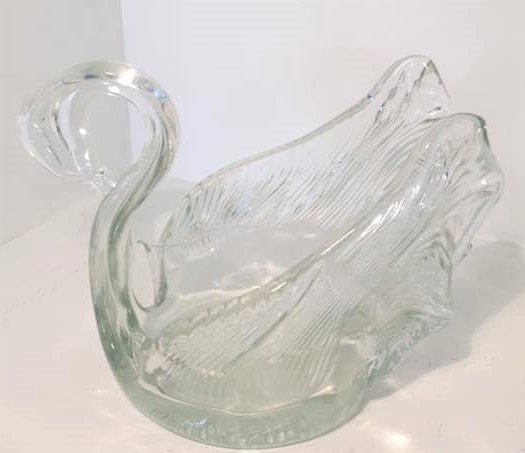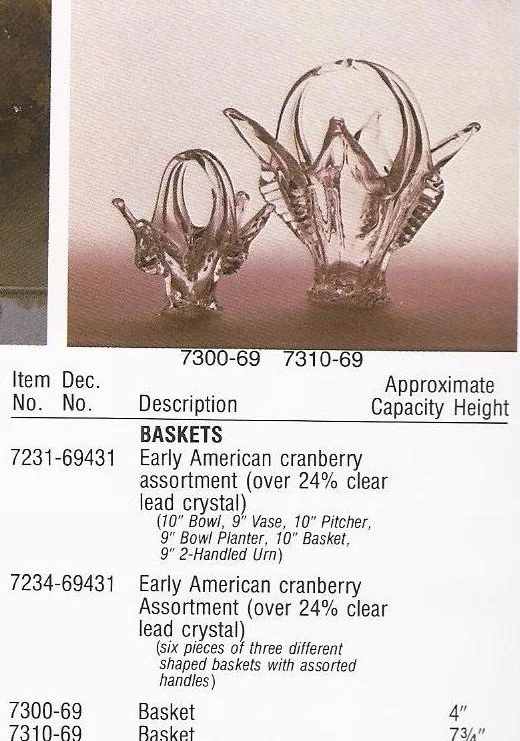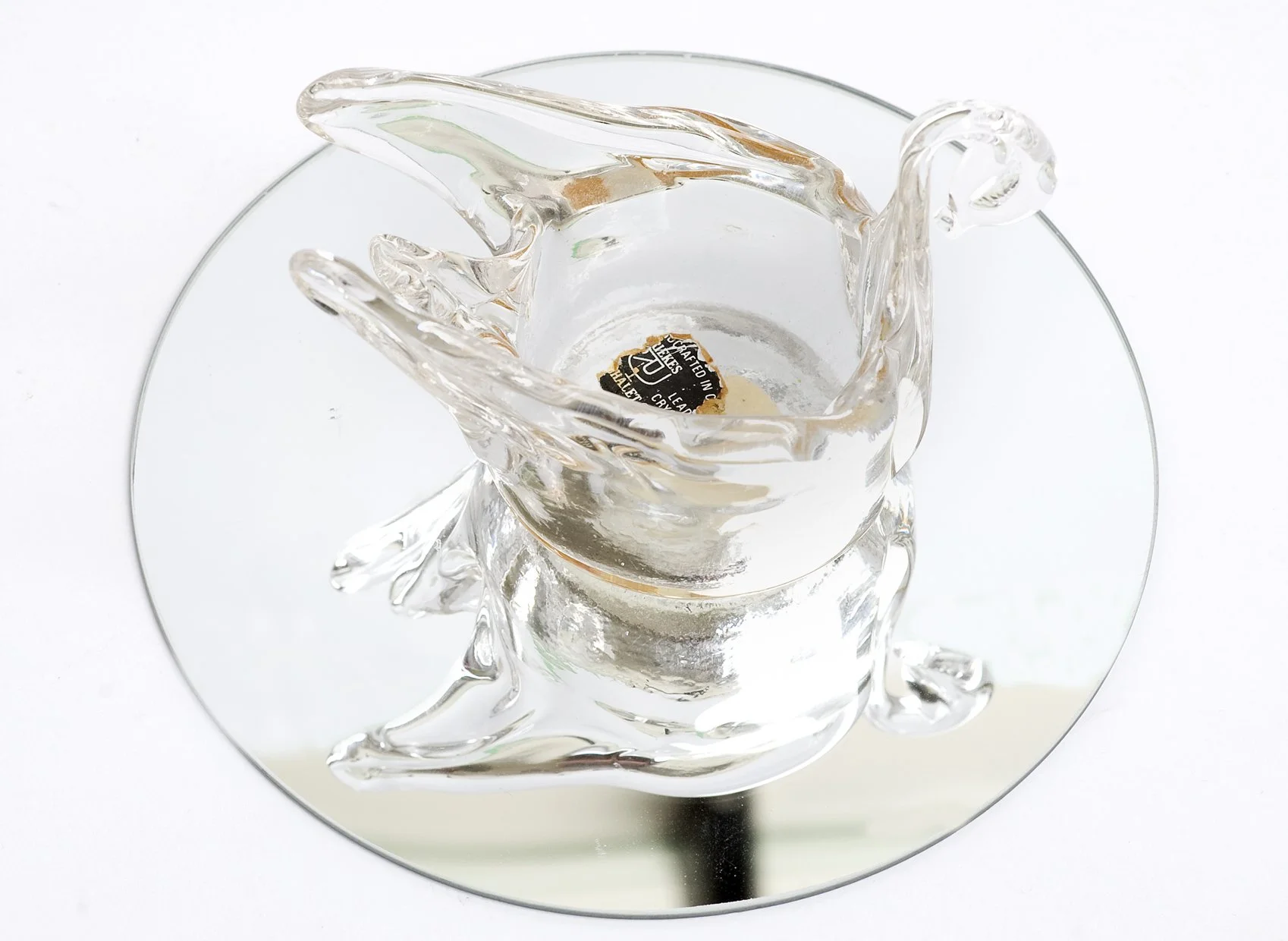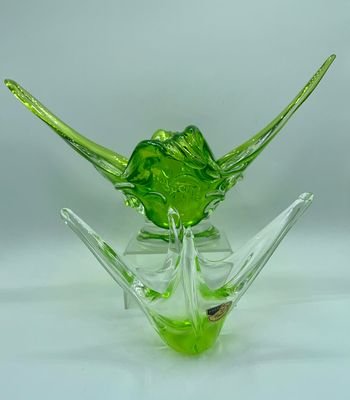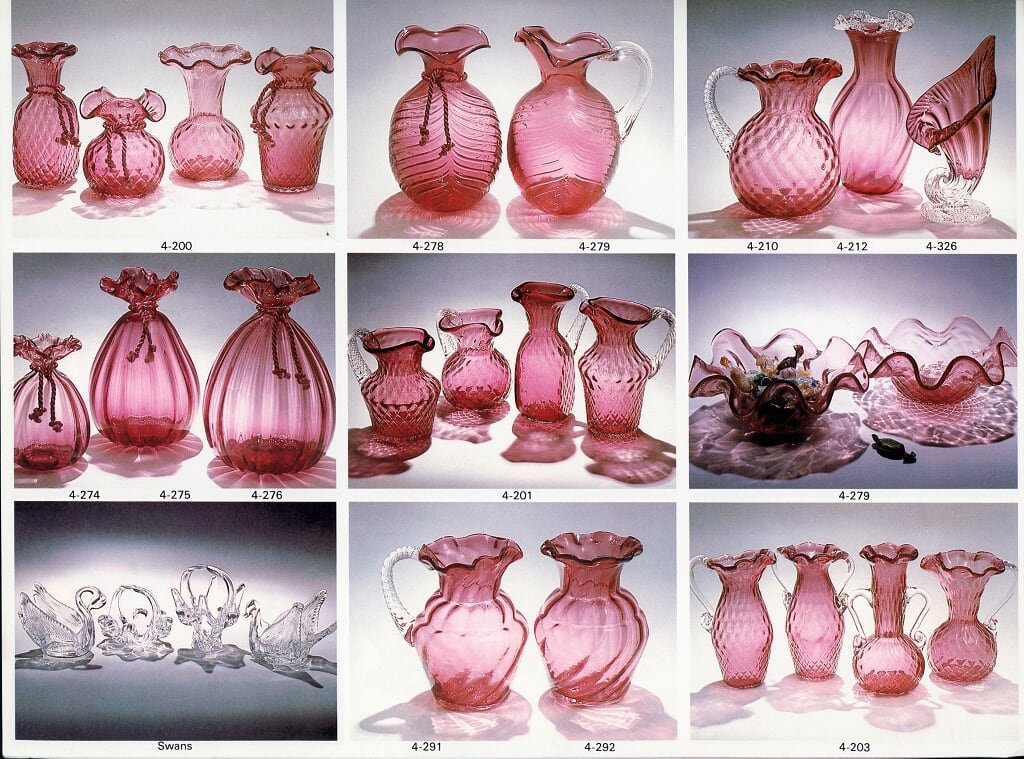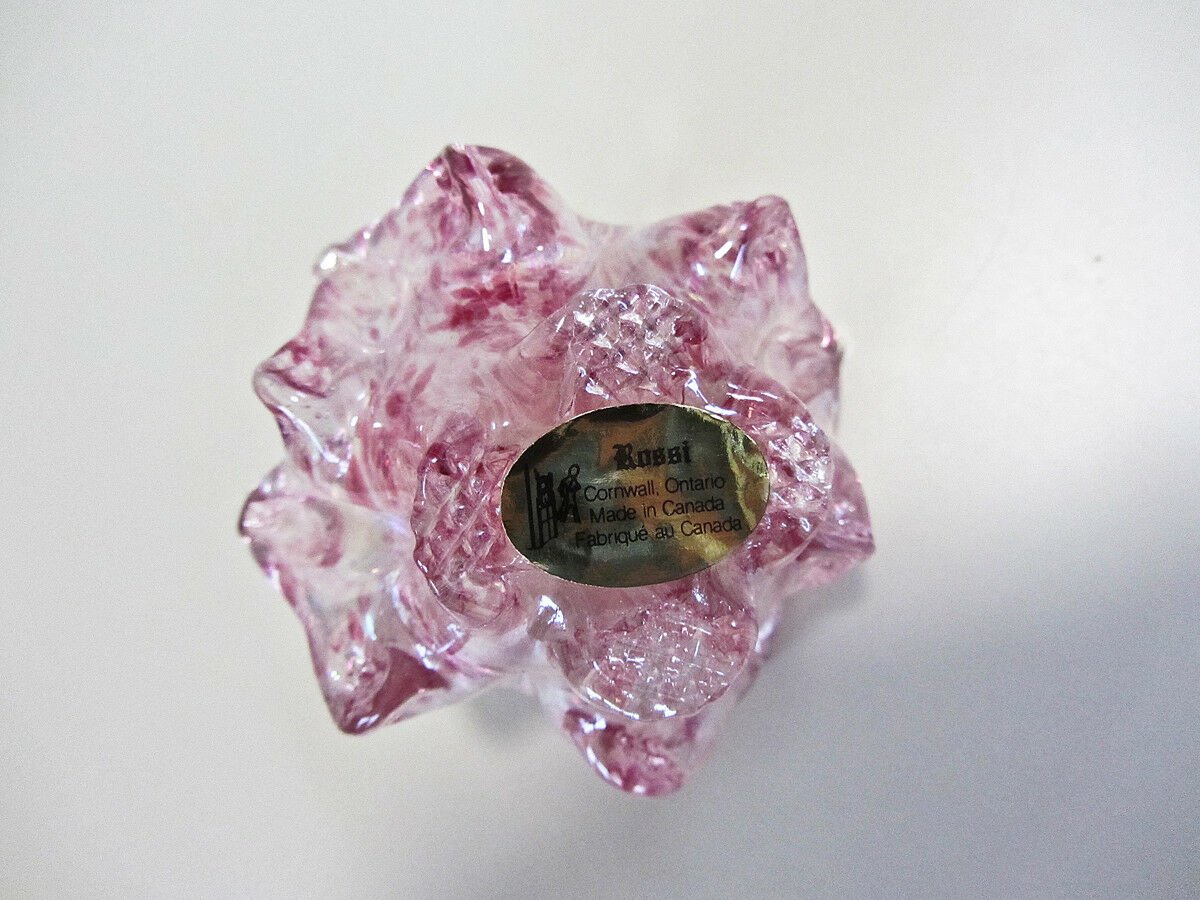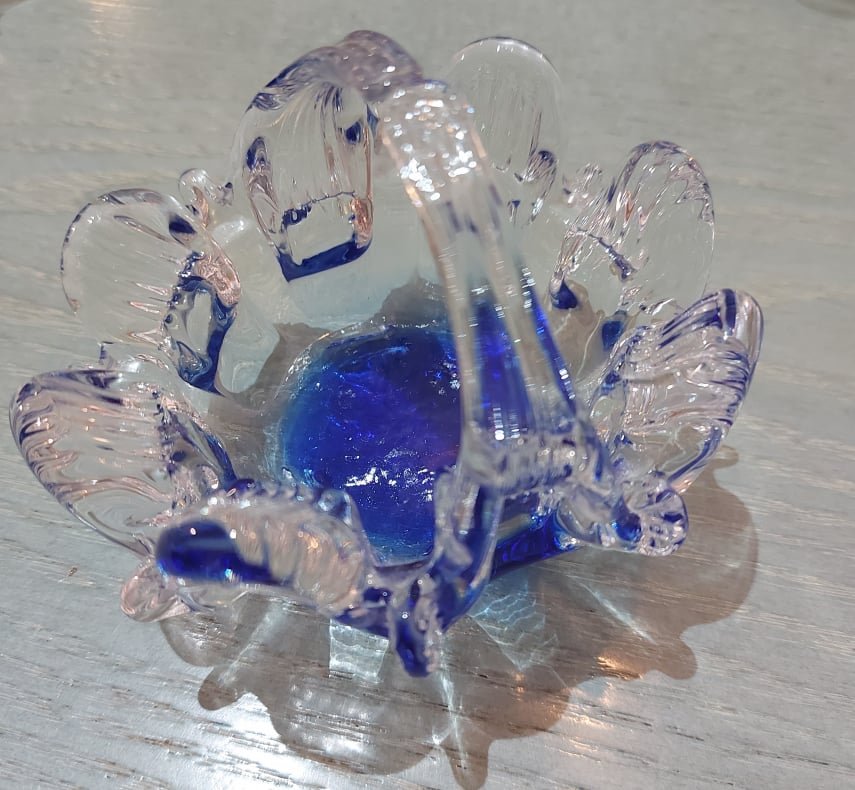Chalet and “Similar yet Different” Bomboniere
Bomboniere: are small decorative pieces made of coloured glass or clear crystal. Can also be spelled bonbonniere. They had a very specific purpose - they were filled with sugared almonds and given as small gifts to guests at special celebrations. Some collectors refer to these as favors or whimsies but please know these are just “pet” names – not terms used by the glass houses. They are very eagerly collected.
By more than one species – just ask Todd! Photos courtesy of 50 Shades member Kevin Kodak.
At this point, we have no evidence that Altaglass or Lorraine Glass Industries produced these forms. However, we do have evidence that in addition to Chalet Artistic Glass, Mosaic Artistic Glass, EDAG, Rossi Artistic Glass and Crystal Craft Industries (both the latter using the Chalet molds) also each produced bomboniere. Unfortunately, to date, I have not seen any verified Mosaic bomboniere pieces that I can show here. However, for the first time, I can show a few pieces from EDAG glass! Rossi only produced a very limited line of bomboniere – 99.9% were swans and baskets. Most Rossi basket and swan bomboniere are virtually identical to the Chalet favors. This is because Rossi and a partner bought Chalet’s equipment after its bankruptcy and the molds for the bomboniere were part of that parcel.
Which was produced at Chalet and which at Rossi? You’ll have to read the article to find out!
This original Chalet bonboniere catalogue page was gifted to me by Chalet Maestro Giulio Gatto. We do have a second Chalet catalog page for the bomboniere but I am not able to show it here as it is only a photocopy and when I scanned it, the quality was even poorer.
A sampling of Chalet bomboniere. From the “whimsical” collection of 50 Shades member Jo Highland.
The bonboniere were hand molded – glassmakers used mouth and a blowpipe rod to blow hot glass into molds. The bonboniere molds were made for Chalet by Corning Glass in New York State. They were steel and of very high quality – long lasting and durable. The piece was finished by hand at end – the pulls, the basket handles, the feet, the indented eyes and the neck and head details of the swans etc. One artist worked the bonboniere – these pieces were not produced by a team. An artist working the bonboniere was expected to produce 80-100 during his shift.
These hand molded pieces have seams (mold lines) as well as a pattern from the molds on their bases. Markedly different from the large Chalet stretch piece, the bonboniere typically have a raised, textured bottom with a grid or cross hatch pattern. However, there are some Chalet bonboniere with a flat, smooth polished base – the candleholder versions.
The most typical Chalet bonboniere base.
A wider flat, polished base. These are typically found on the swan and bird forms designed for use as candleholders.
At the outset, Chalet bonboniere were produced primarily for the Montreal wedding market. The first major Canadian distributors for the Chalet bomboniere were Chantili and Tex- Novelty (Roy Craft). Their markings are stickers. However, Chalet did experiment with etching their signature on the bomboniere - a shell with an etched “Cornwall Canada” on its upper near the nub pull has been discovered. This practice did not go forward as Chalet artist Roberto De Marchi explained that there were complaints from clients and distributors - they did not want this on a little trinket piece that was given as gifts at special occasions. Stickers could be removed. Etchings - never.
These 2 swans are the same form and colour but are stickered with different distributor labels. Swan on left has a “Roy Craft”(Tex Novelty) label while swan on right retains a Chantili sticker. You will frequently find the small gold foil Chantili label on a bonboniere. However, it is much rarer to discover a piece that has a Tex Novelty “Roy Craft” label.
After 1972, bonboniere lines in clear crystal were also distributed by N.C. Cameron & Sons (Canada) and Riekes Crisa (United States). It is common to find pieces that retain Riekes Crisa stickers. However, it is much rarer to discover a piece that still bears a N. C. Cameron sticker.
The larger of these 2 baskets (8” size) is one of the few bonboniere that I have seen retaining a N.C. Cameron label.
Even though you will frequently find coloured bonboniere with the small Chalet lead Crystal label, the coloured bomboniere were glass or “semi-crystal.” Having a lower lead content at 18%. A 24% lead content is needed before glass can be called crystal. Really a distinction without a difference as far as appearance goes regarding the bonboniere.
The coloured bonboniere are found in amber, gold, many shades of blue from light to dark to turquoise, pink and rose, greens ranging from olive to emerald. A very few in purple. An extremely interesting point is that to date, we have found no bonbonierein red or orange. Colour changes were rotated every few days and measured and mixed by hand – this was not an automated process. Therefore, colour was subject to ever changing conditions – the measuring and mixing, cleaning of the crucibles between colour switch outs, the physical condition of the crucibles (they degraded as they aged from the intense heat of the molten glass they contained), the humidity and temperature in the factory, heat in the vats and ovens, the length of time standing… This resulted in ever changing variations and additional proof positives that Chalet “hand worked” their glass. I cannot stress enough that these variations do not show artistic influence. No. Variations are a natural occurring result of manual processes.
Colour placement may be solid throughout, whispered through, just pooled in the bottom or on the edge rims of the piece. And of course, clear crystal.
Solid gold.
Whispers of turquoise blue. Photos courtesy of 50 Shades member Jeremiah Shaver.
Pooled in the bottom.
This swan from the collection of 50 Shades member Lynne Robertson.
A colour rimmed edge.
Filled with sweets and used as a table decoration at special occasions and celebrations, bonboniere were given as gifts to guests at weddings, baptisms, showers and first Communion or Confirmations. Befitting their purpose, Chalet made bomboniere in fanciful shapes – swans, birds, baskets, shells, fish, tiny vases and dishes in flower-like shapes. Although the most typically found are those shown in the catalogue page above, there are many other styles and variations. Some quite rare. And rather bizarre! The Chalet “fish” bonboniere come to mind instantly.
There appears to have been 2 Styles of Chalet fishbonboniere. Neither of these are shown on either of the Chalet catalog pages in my possession.
A most unusual pair to bear the “Roy Craft” label not only in style but that they are clear crystal. From the collection of 50 Shades member Lorne Olafson.
Phot courtesy of 50 Shades member Josh Dolstra.
The bonboniere forms typically have a size range. For example, the swans came in 3 sizes – 4”, 5” and 6”. The basket and swan forms are the most iconic of the Chalet bonboniere. They are found in different stylings as well as being produced in more than one size.
A medium and small sized swan. The 4” swan is the most commonly found. The medium scarcer.
You will also note different surface finishes.
An exceedingly rare over-sized swan with an irradato finish. . You will note the difference in pose of the wings from the ones directly preceding. This is the “Wings Up” pose while the former is the “Wings Back” style. Both are found in the “head to the chest” style. Photo courtesy of 50 Shades member Daniel Lynch.
The swan form can have either 1 or 2 heads. The 2 headed piece is much scarcer.
Other styling differences in the swan forms are also seen. The green swan at left in this photo is the more typically seen with finer detailed wings and head and a narrower body. The blue swan on the right with the irradato finish is the “Wings Up” variation of the “head out” style # 1022, 1042, and 1043 shown on one of Chalet bonboniere catalogue pages. It has less head and wing detail, a flatter and wider body and an outstretched head pose rather than the head tucked to the neck. These pieces were on display at the 2010 Chalet exhibit in Cornwall, Ontario.
This pair of the “head out” catalogue page listed Chalet swan bonboniere from the collection of Gioony Gueli.
Look closely at this grouping. Not only will you see the headed different forms, you will notice subtle differences in colour, detail and body shape. Evidence of hand worked molded forms.
The basket bonboniere came in 5 variations of style. As well, some were produced in more than one size.
This first style is shown on the Chalet catalog page above.
It was produced in 3 sizes. Production #1035 stands 4”, Production #1037 being 6” in height and Production #1039 larger at 8” inch. This is the 8” basket. And the question asked above regarding the maker of this basket is now answered - it is not only stickered Chalet but the pink one above is stickered Rossi. Moreover, as you will see in the Rossi bomboniere section below, Rossi did not do clear coloured bonboniere like these so routinely done at Chalet.
Another style. It is not shown on the Chalet catalog page above. However, it is featured on the Chalet catalog sheet that I was not able to include. It is Production #1079 and is 4 ½”.
This third basket style has also been found in 4, 6 and 8” heights. This style is not shown in either of the Chalet catalog pages I have. However, we have found it marked with Chalet labels and Chalet distributor labels. As well, it is carried in clear crystal in the Riekes catalogs under the Chalet “Assortments” and the Chalet baskets. Although as seen above, Rossi did do basket bomboniere in this shape, as noted, he did not produce clear coloured pieces. Therefore, identification of this type of coloured bomboniere is straightforward because of the colour - if not the shape. However, identifying unstickered clear crystal and “irradato”baskets and swans can get more difficult. More following regarding this subject.
.
A fourth style basket. Production #1012 is listed as 3 ½” RD” on the Chalet catalog page above. I believe that those initials indicate “round” as on the second Chalet catalog page not shown here, it is now Production #1008. Found in a wide range of colours.
The fifth style.
This basket style had a squared body style and came in 2 sizes – 3 ½ was Production #1012SQ and the larger 4” size was Production #1014. They are both shown on the Chalet catalog page above. However, like the preceding amber bomboniere, their production number changed on the 2nd Chalet catalog page I have for the bomboniere. It is now Production #1077 (3 ½”) and the larger 4” size was changed to Production #1078. In addition to the different body shape, the pulls on this style are like flower leaves or petals as compared to the smaller rounded pulls on the #1012RD/#1008 style above.
From the collection of 50 Shades members Kevin Kodak and Tracey Shanley.
A rare variation of the Production #1078 basket form directly adjacent. Note that there are no handles. From the collection of 50 Shades member Carol Lincz.
This style came in 3 sizes – ranging from the smallest at 1 ½ high x 3” diameter” to the largest at 3 inches in height by 6 inches wide. The Chalet catalog page above only shows production numbers for 2 of the sizes – # 1011 and #1013.. These will nestle and stack together.
From the collection of 50 Shades member Ella Hanks.
They were made in a wide range of colours.
To date, we know of 3 styles in 2 different sizes of the shell bomboniere – and they are all shown on the Chalet catalog page above. The most common, Production # 1009 and #1010, have spikey pulls (which can either be clear or coloured) and a “twisted nub” pull at the narrowest point of the piece. These came in 3 ½” and a 5 ½” sizes. A variation, Production #1045, has a smooth rounded edge but still with the “twisted nub” pull at the narrowest point of the piece. Although it is only shown on the catalog page above in one size, the 3 ½”, the 5 ½” size is featured on the Chalet catalog sheet that I was not able to include. It is Production #1046. These rounded edge shells are not as often seen. And the scarcest is the 3rd version – Production #1044. It has spikey pulls at the edges but the end pull is folded over and back into the body of the bomboniere – it is not twisted upwards. It is only shown in a 3 ½” size and at present that is the only size that has been found.
Note the differing sizes, end and edges pulls. From the collection of “shellshocked” 50 Shades member Jo Highland.
These 3 ½” shell bomboniere each have different end pulls but are the same size. The shell on the left, Production #1044, is another from the collection of 50 Shades member Jo Highland. Photo of the shell on the right, Production #1009, courtesy of Chalet Vintage Art Glass Gallery.
The 3 ½” Production # 1045 and the 5 ½” Production # 1010. Different sizes and differing edges. These shells from the collection of 50 Shades member Cindy Bishop Laughlin.
This style of bird (Production # 1022, #1042 and #1043) was made in 3 sizes ranging from 5” to 7”. This is the larger 7” bird (#1043).
Mama (#1043) and fledgling (5”). A lovely set from the collection of 50 Shades member Carol Lincz.
And then we have the big fellas! Not a listed production size! This very large threesome from the collection of 50 Shades member Gionny Gueli.
Lesser seen bomboniere.
Not shown on the Chalet catalog page above but 2 sizes are featured on the Chalet catalog sheet that I was not able to include. They are Production #1076 at 3 ½” and Production #1080 which is shown as 4 ½”. This style is seen in all the Chalet bomboniere colour palette as well as clear crystal – see a blue shown above and a surprise below! This piece from the collection of 50 Shades member Lynne Robertson.
This is #1077. It is the only one of this style that I have seen to date. From the collection of 50 Shades member Carol Lincz.
This bomboniere vase was made in 4”, 6”, and 8 inch heights. Shown on the Chalet catalog page above as Production pieces #1034, 1036 and 1038. This has also been seen in green and amber. From the collection of 50 Shades member Cindy Bishop Loughlin.
This bomboniere dish was made in 4”, 6”, and 8 inch widths. Shown on the Chalet catalog page above as Production pieces #1017, 1018 and 1019. From the collection of 50 Shades members Kevin Kodak and Tracey Shanley.
Rarely seen bomboniere:
Both the coloured and clear crystal Chalet owl bomboniere are very rare. The clear crystal were made for Riekes Crisa. Only 4 have been found to date and are larger than their coloured cousins.
A handful of blue have been found – all bearing the small gold Chalet lead crystal sticker. Even rarer is the green owl below - at present, we know of only 2.
These “3 amigos” are from the collection of 50 Shades member Paolo De Marchi. Paolo’s father, Roberto De Marchi, is a Chalet artist who worked extensively with the bomboniere so that particular form holds a special place in Paolo’s collecting.
An extremely interesting and to date, “one of a kind” variation of this rare form from the collection of 50 Shades member Gionny Gueli. Note the differences in face and tail from the ones preceding. Also note the colour is not solid but “mottled”. This colour placement treatment is seen in some of the swan bomboniere but I have never seen it in any of the owls before.
Although we see this on the Chalet bomboniere catalog page as Production #1081, this is the only the second bomboniere of this style that I know of to date. From the collection of 50 Shades member Joan Jet.
From the collection of 50 Shades member Kim Tersteeg.
It was not unusual for Chalet to do custom bomboniere for special orders.
This lovely bomboniere from the collection of 50 Shades member Kim Tersteeg one such example of a special piece for a special occasion
And then we have the odd and strange – totally atypical colours in production pieces. But odd and strange twists to production is totally in keeping with Chalet’s consistent inconsistency.
Photograph courtesy of 50 Shades member Jeremiah Shaver.
However, the “creamy” looking large basket at left rear in the following photograph is actually not a colour choice. It is a “smoked” amber basket. The artists used this term to describe glass that was “over cooked.” Pieces exposed to too much heat. This would have been considered a second back in the day whereas today, collectors put a premium on these pieces.
From the colourful collection of 50 Shades member Jo Highland.
And astonishingly – some uranium bomboniere have come “to light.” Literally! Definite “Never say Never” pieces!
The large 8” Chalet uranium basket bomboniere in the top row is safely in the hands of 50 Shades member Jo Highland. A second uranium piece (bottom row) has been found. It is also an 8” basket. The two are likely to have been made at the same time. Photos of this basket bomboniere courtesy of 50 Shades member Ryan Shawn Robertson.
And the 3rd that we know of to date is even more astonishing as it is a seldom seen shape in the even rarer larger size!
This “firecracker” from the collection of 50 Shades member Carol Lincz.
Chalet and Rossi also produced bomboniere that has a surface treatment of the glass. Both companies achieved a “irradato” finish by treating a piece, while still hot, with metal chlorides. Traditionally this finish was produced by drenching a piece at the final stages with kerosene and then burning off the oil.
The most typical pieces seen with an iridescent finish are baskets and swans. Most common colours we see in Chalet made iridised bomboniere are pinks, greens, and blues. We also see a fair number of “irridato” clear pieces.
This crystal “irradato” swan bomboniere was made by Chalet artist Roberto De Marchi. It remains in the possession of the De Marchi family.
A great bomboniere irradato swan and basket duo. Swan retains a Chantili sticker. This swan has 2 heads – the much rarer styling.
Style variations from the pink above and green below but same iridescent finish.
Endless variations. This photo courtesy of 50 Shades member Daniel Lynch.
Very rare are the opaline. Unlike “irradato” glass, opaline is not a surface finish – lead arsenate was added to molten clear crystal which turns the glass opaque. It is no longer transparent. Chalet also created opaline animal figurines which were carried in their “Boutique Collection” line. They are also exceedingly rare. Please note that Chalet did not produce solid coloured opaline pieces as Rossi did. See the Rossi section below for examples.
Exceedingly rare pair of opaline fish.
Picture courtesy of 50 Shades member Jackie Lynn.
And a very newly discovered beauty. Lead arsenate would have been added to an olive colour mix to achieve this affect. A stunning variation from the 8” olive and clear crystal basket shown above. From the collection of 50 Shades member Lorne Olafson.
Very, very rare are the shimmering opaline pieces. Chalet artist Roberto De Marchi does not remember Chalet producing very many of these opalescent bomboniere and thinks that the ones made were to fill custom orders. As the mix would have had to contain lead arsenate to make the glass opaque and then metal chlorides to achieve the iridescent finish, this was not the standard production norm. It was much too time consuming and costly. Therefore, this would most likely have been custom work outside of normal production.
Same form but 2 completely different looks. The clear crystal candleholder bomboniere retains a Riekes sticker while the opalescent is stickered with the Chantili label.
Another example. It retains, barely, the vestiges of the small gold “Chalet Lead Crystal” label.
We have occasionally seen bomboniere with gold accents. To date, we have no evidence that Chalet produced any bombomiere with gold. The artists have said, “Not Chalet” when shown both of these examples.
Photos courtesy of 50 Shades member Bob Burgess.
Photos courtesy of 50 Shades members Ian and Lorraine Cox.
The Chalet bomboniere lines distributed by Riekes Crisa:
Bomboniere were also produced for Chalet’s American distributor Riekes Crisa. These lines were shown in both the Riekes catalogs that we have. These were only in clear crystal. Canadian distribution of clear crystal was typically through N. C. Cameron and Sons as shown above.
This clear crystal shell bears a Chantili sticker but it typically would bear a Riekes Crisa label as it is shown above in the “Outstanding Assortment” (top picture, left) in their 1976 General Catalog. Ironic – Chalet was no longer operating. From the collection of 50 Shades member Ella Hanks.
A very rare clear crystal dish bomboniere from 50 Shades members and collectors Kevin Kodak and Tracey Shanley.
Not only could you buy the swans and baskets as part of an assortment, but they could also be purchased on their own. A testament to the popularity of these forms.
This clear crystal swan from the collection of 50 Shades member Lynne Robertson.
This 8” basket (left) and 6” basket (right) are bomboniere from the collection of 50 Shades member Brad McGillivray.
Bomboniere are also presented in the Riekes catalogues for use as candleholders. Again, you see the swan form here. There are some differences – modifications based on usage. The candle holders do not have a rounded, mold marked bottom. They are always either footed or have a flat polished base. For the obvious reason of stability. And the tops were always open so that the flame would not touch glass. Therefore, it is obvious why a basket candleholder was not feasible.
An “assortment” from 50 Shades member Ella Hanks.
I am going to end the Chalet bomboniere with a curiosity and a caution. Chalet made molded “hand-held’ ashtrays. These were literally made to fit in the palm of the hand as they were used by smokers moving around at parties, conventions, in bars etc. They have a patterned base, are about the same size as the small bomboniere and the shape is similar. However, if you look closely, you will see a butt rest. Do not mistake them for bomboniere.
Pictures of amber piece on left courtesy of 50 Shades member Paolo De Marchi.
EDAG bomboniere
It is very exciting that, for the first time, we see that EDAG produced bomboniere. Maestro Pavenello has confirmed that like Chalet, EDAG made these largely for the Montreal wedding market. We have few other details but do have some examples! These show that the most distinctive characteristic of the EDAG bomboniere and the most distinctive difference from Chalet bomboniere is that the EDAG bomboniere are hand formed – not hand molded.
However, this being said and true in 99.9% of the EDAG/Chalet comparisons there is always the exception to the rule. It’s why we say “Never say Never.”
The epitome of “similar yet different.” This EDAG bombonierre could very easily be mistaken for Chalet #1011 - see following photographs.
Let’s do a comparison - the colour is the same and both have 8 upward pulls BUT note - the EDAG piece (left) piece has no mold seams or base markings. It was hand formed not hand molded. It is also slightly larger than the Chalet bomboniere #1011 on the right. These EDAG and Chalet bomboniere from the collection of 50 Shades member Cindy Bishop Laughlin.
More examples of this EDAG style in other colours and clear crystal. They were created by EDAG Maestro Danilo Pavenello. Photo courtesy of Tamara Boutros.
Like Chalet, EDAG did produce a shell bomboniere. These, however, are not similar to the Chalet shells as the styling is obviously reflective of how the piece was hand formed as well as it being much larger than the Chalet versions.
This piece is approximately 5”- 6” in length.
It was made by Maestro Danilo Pavenello and also remains in the possession of the Pavenello family. Photo courtesy of Tamara Boutros.
This lime green beauty is from the collection of 50 Shades member Sabrina Luna. It measures 8” in length, 6” in diameter and is 4” in height. It is larger than the amber shown above.
The lack of mold seams in the body of this form and its smooth polished base is testament that it is hand formed.
An ashtray like bomboniere. The lack of mold seams in the body of this form and its smooth polished base is testament that it is hand formed.
Another line of EDAG bomboniere holds even more surprises.
This style of EDAG were bomboniere – not “picolli”. We have seen quite a few of these forms and have wrongly assumed they were EDAG “minis” based on their size. However, Maestro Pavenello has stated that they were produced as table bomboniere.
Like Chalet, uranium was used in some EDAG bomboniere. Theses stunners are from collection of Luna Sabrina.
EDAG “picollo” basket on left and EDAG bomboniere basket at right. Very similar in size but function and purpose were totally different. Again, from the collection of Luna Sabrina.
EDAG “picollo” basket on left and EDAG bomboniere basket at right. Very similar in size but function and purpose were totally different. Once more, photos courtesy of Luna Sabrina.
Rossi bomboniere
Rossi bomboniere bear a variety of labels – 3 different are shown here. Finding a stickered Rossi bomboniere is quite rare. They were typically the basket and swan forms and done in clear crystal, coloured opaline or coloured irradato. He did not produce clear coloured bomboniere like Chalet.
Another first – being able to show a Rossi Artistic Glass catalog page!
A Rossi Artistic Glass catalog page. 1988. Bomboniere in lower left corner. Thanks to Don Smith, curator, Cornwall Community Museum and 50 Shades member for making available
This Rossi opaline swan retains a very early label which is paper not foil so it did not wear well. This one is almost illegible. There is simply a red maple leaf graphic and the words “Rossi Artistic Glass” and “Made in Canada”. See “Chalet Crystal Clear” for additional Rossi pieces with this label.
A Rossi basket. Identical to a Chalet form as the same molds were used as explained above. You may see blue coloured opaline bomboniere identified as “Chalet” which is a common identification mistake because of the form commonality. However, Chalet did not produce coloured opaline bomboniere so separating this type of bomboniere is straight forward despite the mold/form issue.
The most typical Rossi bomboniere in form, colour, size and finish. Since Chalet also did this form in this colour and finish, if a piece is not marked, it is virtually impossible to identify the maker.
This “irradato” finished basket bears the charming Rossi “canna” sticker as also seen on the piece directly following. This is an older label. However, there are 2 versions of this label. See the later version on the blue basket which follows the green.
Photos courtesy of 50 Shades members Geoffrey Chown and David Dunkley.
As shown on the Rossi catalog above, Rossi commonly did baskets and swans in clear crystal as well.
From the collection of 50 Shades members Kevin kodak and Tracey Shanley.
2 unusual Rossi bomboniere in form as they are neither a swan nor basket. However, both are very typical in colour, finish and marking.
These bomboniere are from the collection of 50 Shades member Pam Petten.
Crystal Craft Industries (a small Toronto glasshouse in the 1980’s) ended up with the Chalet bomboniere molds after the partnership of Angelo Rossi and Morris Jaslow ended and Artistic Glass in Cornwall ended. CCI was another of Jaslow’s companies and he obviously retained possession of the Chalet molds he and Rossi bought in 1975 at the Chalet bankruptcy sale. It is disconcerting to see iconic Chalet forms branded with another company’s marking.
These CCI pieces were made circa 1982/1983 using Chalet swan, basket and candleholder molds.
This vase (directly below) and basket (following vase) bomboniere are good examples of how closely Murano made can look to Chalet produced bomboniere. Vase from the collection of 50 Shades member of Reg Lennox.
From the collection of 50 Shades member Cindy Bishop Loughlin.
This Murano stickered bomboniere from the collection of 50 Shades member Kevin Hall is another clear example of how deeply Chalet was influenced by Italian tradition and heritage. If you were just breezing by, you could easily mistake this for Chalet produced because of its size, shape and the pulls. However, note the smooth polished base and this is not a typical colour for Chalet. Although, as shown above, we have found purple bomboniere.
Well, I have come to “the bomboniere end.” And what better way to end than with a 50 Shades “Finn the Wandering Whimsey” send off. He’s the perfect reminder of how popular the bomboniere still are with collectors.
Finn in Winnipeg. Hosts were 50 Shades members Kevin Kodak and Tracey Shanley.
